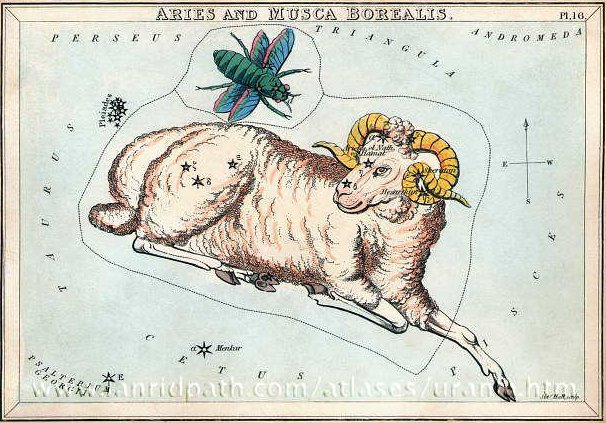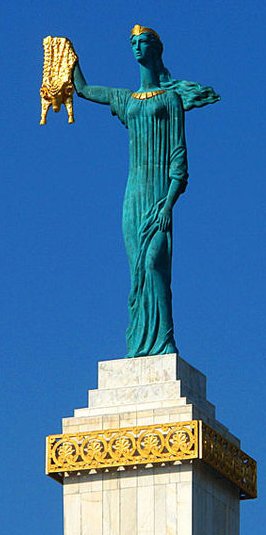The last (10th) Tahitian star pillar (ana) was
Polaris, and this was a place to fish by:
|
1 |
Ana-mua, entrance pillar |
Antares, α Scorpii |
|
2 |
Ana-muri, rear pillar (at the foot of which was the place for tattooing) |
Aldebaran, α Tauri |
|
3 |
Ana-roto, middle pillar |
Spica, α Virginis |
|
4 |
Ana-tipu, upper-side-pillar (where the guards stood) |
Dubhe, α Ursae Majoris |
|
5 |
Ana-heu-heu-po, the pillar where debates were held |
Alphard, α Hydrae |
|
6 |
Ana-tahua-taata-metua-te-tupu-mavae, a pillar to stand by |
Arcturus, α Bootis |
|
7 |
Ana-tahua-vahine-o-toa-te-manava, pillar for elocution |
Procyon, α Canis Minoris |
|
8 |
Ana-varu, pillar to sit by |
Betelgeuze, α Orionis |
|
9 |
Ana-iva, pillar of exit |
Phakt, α Columbae |
|
10 |
Ana-nia, pillar-to-fish-by |
North Star, α Ursae Minoris |
| Antares |
α Scorpii |
1.06 |
26° 19′ S |
16h 26m |
249.1 |
|
Aldebaran |
α Tauri |
0.87 |
16° 25′ N |
04h 33m |
68.2 |
| Spica |
α Virginis |
0.98 |
10° 54′ S |
13h 23m |
202.7 |
|
Dubhe |
α Ursa Majoris |
1.81 |
62° 01′ N |
11h 01m |
166.7 |
|
Alphard |
α Hydrae |
1.99 |
08° 26′ S |
09h 25m |
142.3 |
| Arcturus |
α Bootis |
-0.05 |
19° 27′ N |
14h 13m |
215.4 |
|
Procyon |
α Canis Minoris |
0.34 |
05° 21′ N |
07h 37m |
114.9 |
|
Betelgeuze |
α Orionis |
0.58 |
07° 24′ N |
05h 52m |
88.3 |
|
Phakt |
α Columbae |
2.65 |
34º 06' S |
05h 38m |
84.7 |
| Polaris |
α Ursae Minoris |
1.97 |
89º 02' N |
01h 49m |
26.6 |
|
If new land was to be fished up from the site of
Polaris, then there seems to be a good agreement with
the structure in the C text, because here Polaris was at
the last glyph on side a of the tablet.
|
 |
 |
225 |
 |
28 |
 |
|
Ca5-31 (136) |
Ca5-32 |
Ca13-20 (363) |
Ca14-29 (392) |
|
TALITHA AUSTR
(*136) |
9h (*137.0) |
DZANEB (*362) |
POLARIS (*392
- *366) |
|
21h (*319.6) |
DRAMASA
(*320.0) |
PHEKDA (*179) |
BENETNASH
(*391 - *183) |
|
256 = 16 * 16
= 227 + 29 |
Then would follow 4 more days in order to reach Hamal (α at
the crown of Aries):
 |
29 |
 |
10 |
 |
3 |
 |
17 |
 |
255 |
 |
|
Gb6-26 (408) |
Gb7-28 |
Gb8-8 |
Gb8-12 |
Gb8-30 |
Gb2-1 (256) |
|
Sirrah (0h) |
Hamal (*30) |
Bharani |
Algol (*45) |
Hyadum I |
Dramasa |
|
64 |
256 (= 4 *
64) |

 |
 |
 |
 |
|
Cb1-1 |
Cb1-2 |
Cb1-3 |
Cb1-4 (396) |
| E
tupu - ki roto |
o te hau tea |
ki te henua -
te maro |
|
Al Sharatain-1 /
Ashvini-1 /
Bond-16 (Dog) /
Mahrū-sha-rishu-ku-1 (Front of the Head of Ku)
SEGIN =
ε
Cassiopeia, MESARTHIM =
γ
Arietis,
ψ
Phoenicis (27.2),
SHERATAN (Pair of Signs)
=
β
Arietis,
φ
Phoenicis (27.4)
*351.0 = *27.4 - *41.4 |
ι Arietis (28.0), λ Arietis (28.2), υ Ceti
(28.8) |
ALRISHA (The Knot) = α Piscium, χ Phoenicis (29.2), ε Trianguli (29.4),
ALAMAK (Caracal)
= γ Andromedae
(29.7)
*353.0 = *29.4 - *41.4 |
Arku-sha-rishu-ku-2 (Back of the Head of Ku)
2h (30.4)
κ
Arietis (30.3),
HAMAL (Sheep)
=
α
Arietis
(30.5)
ALKES (α
Crateris)
*354.0 = *30.4 - *41.4 |
|
April 17
(107) |
18 |
19 (80 + 29) |
20 |
|
'March 21 (80) |
22 |
23 |
24 |

 |
... The present limit of the
celestial polar regions can be
defined from the declination of the
star
γ
Andromedae
... Its current place is at
declination 42º 05' N. In other
words the measure across the polar
regions should be 2 * (90º - 42º
05') = 2 * 47º 55' = 95º 50' or
around 96º. The width of the polar
regions is thus around 2 * 96º =
192º
and 360 - 192 =
168 = 2 * 84 (→ Julian spring
equinox).

... In Babylonia the constellation
[Triangulum] was named Apin and it
included Alamak (γ
Andromedae):

... This
is Alamac in the Alfonsine
Tables and 1515 Almagest;
Riccioli's Alamak;
Flamsteed's Alamech; now
Almach, Almak,
Alamaack, and Almaac or
Almaak; all from Al 'Anāk
al 'Ard, a small predatory
animal of Arabia, similar to a
badger, and popularly known there as
Al Barīd.
Scaliger's conjecture that it is
from Al Mauk, the Buskin,
although likely enough for a star
marking the left foot of Andromeda,
is not accepted; for Ulug Beg, a
century and a half previously, as
well as Al Tizini and the Arabic
globes before him, gave it the
animal's name in full. But the
propriety of such a designation here
is not obvious in connection with
Andromeda, and would indicate that
it belonged to
very early Arab
astronomy
...
... Gamma Andromedae ... is
the third brightest star in the
constellation of Andromeda. It is
also known by the traditional name
Almach (also spelt as
Almaach, Almaack,
Almak, Almaak, or
Alamak), from the Arabic
العناق
الأرض
al-‘anāq al-’arđ
...
'the caracal' (desert lynx).
Another term for
this star used by medieval
astronomers writing in Arabic was
آلرخل
المسلسلة
Al Rijl al
Musalsalah
'the Woman's Foot'. In Chinese,
天大將軍 (Tiān
Dà Jiāng Jūn), meaning
Heaven's Great General, refers
to an asterism consisting of
γ Andromedae,
φ Persei,
51 Andromedae, 49 Andromedae,
χ Andromedae,
υ
Andromedae, τ
Andromedae, 56 Andromedae, β
Trianguli, γ
Trianguli and δ
Trianguli. Consequently, γ
Andromedae itself is known as
天大將軍一 (Tiān
Dà Jiāng Jūn yī, English:
the First Star of
Heaven's Great General.)
In the catalogue of stars in the
Calendarium of Al Achsasi al
Mouakket, this star was designated
جمس
ألنعامة
Khamis al Naamat,
which was translated into Latin as
Quinta Struthionum, meaning
the fifth ostrich ...
... The
name 'lynx' originated in Middle
English via Latin from Greek word 'λύγξ',
derived from the
Indo-European
root '*leuk-', meaning 'light,
brightness' ...
...
Caracal ... feline animal of N.
Africa ... F. or Sp. caracal
- Turk. qarahqulaq, f.
qarah black + qulak ear
...
|
... In the description of the Babylonian zodiac given in
the clay tablets known as the MUL.APIN, the
constellation now known as Aries was the final station
along the ecliptic. It was known as MULLÚ.ḪUN.GÁ,
'The Agrarian Worker'. The MUL.APIN is held to have been
compiled in the 12th or 11th century BCE, but it
reflects a tradition which takes the Pleiades as marking
vernal equinox, which was the case with some precision
at the beginning of the Middle Bronze Age (early 3rd
millennium BCE). In later Babylonian tradition, the name
of the constellation changes to MULUDU.NITÁ
'ram'. The motive for the name change is unknown. John
H. Rogers suggests that the 'Agrarian Worker' became the
'Ram' via association with the legendary figure of
Dumuzi the Shepherd. Gavin White suggests that the
sumerogram LÚ 'man' may have come to be understood as
Akkadian lu 'sheep'.
Aries only rose to its prominent
position as the leading sign of the zodiac in the
Neo-Babylonian (7th century BCE) revision of the
Babylonian zodiac, as Hamal (α
Ari) came to be located close to the point of vernal
equinox. In Hellenistic astrology, the constellation of
Aries is associated with the golden ram of Greek
mythology that rescued Phrixos on orders from Mercury,
taking him to the land of Colchis. Phrixos sacrificed
the ram to the gods and hung its skin in a temple, where
it was known as the Golden Fleece. The Golden Fleece was
then stolen by Jason and the Argonauts ...
... The Symplegades ... or
Clashing Rocks, also known as the Cyanean Rocks,
were, according to Greek mythology, a pair of rocks at
the Bosphorus that clashed together randomly. They were
defeated by Jason and the Argonauts, who would have been
lost and killed by the rocks except for Phineus' advice.
Jason let a dove fly between the rocks; it lost only its
tail feathers. The Argonauts rowed mightily to get
through and lost only part of the stern ornament. After
that, the Symplegades stopped moving permanently ...
... The Argonauts, with the Golden
Fleece on board, had to pass the Symplegades, the
clashing rocks. Once a ship with its crew came through
unharmed - so the 'blessed ones' (makaroi) had
decided long ago - the Symplegades would stay fixed, and
be clashing rocks no longer. After that 'accepting the
novel laws of the fixed earth', they should 'offer an
easy passage to all ships, once thay had learnt defeat'.
This is only one station on the long 'opening
travel' of the Argonauts transporting the Golden Fleece
(of a ram), undertaken in all probability to introduce
the Age of Aries, but it demonstrates best the relevant
point, namely, 'the novel laws' ...

|








